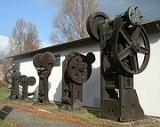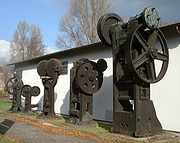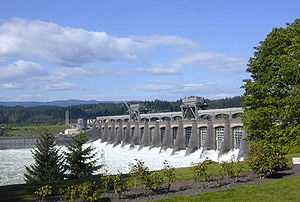
Machine Age
Encyclopedia



World War I
World War I , which was predominantly called the World War or the Great War from its occurrence until 1939, and the First World War or World War I thereafter, was a major war centred in Europe that began on 28 July 1914 and lasted until 11 November 1918...
and second
World War II
World War II, or the Second World War , was a global conflict lasting from 1939 to 1945, involving most of the world's nations—including all of the great powers—eventually forming two opposing military alliances: the Allies and the Axis...
world wars, it forms a late part of the Industrial Age
Industrial Revolution
The Industrial Revolution was a period from the 18th to the 19th century where major changes in agriculture, manufacturing, mining, transportation, and technology had a profound effect on the social, economic and cultural conditions of the times...
. By the mid to late 1940s, the atom bomb , the first computers , and the transistor
Transistor
A transistor is a semiconductor device used to amplify and switch electronic signals and power. It is composed of a semiconductor material with at least three terminals for connection to an external circuit. A voltage or current applied to one pair of the transistor's terminals changes the current...
came into being , beginning the era of high technology and thus ending the intellectual model of the machine age founded in the mechanical and heralding a new more complex model of high-technology.
Artifacts of the Machine Age include:
- Mass productionMass productionMass production is the production of large amounts of standardized products, including and especially on assembly lines...
of high volume goods on moving assembly lineAssembly lineAn assembly line is a manufacturing process in which parts are added to a product in a sequential manner using optimally planned logistics to create a finished product much faster than with handcrafting-type methods...
s, particularly of the automobileAutomobileAn automobile, autocar, motor car or car is a wheeled motor vehicle used for transporting passengers, which also carries its own engine or motor... - Gigantic production machinery, especially for producing and working metal, such as steel rolling mills, bridge component fabrication, and automobile body presses
- Powerful earthmoving equipmentEngineering vehicleHeavy equipment refers to heavy-duty vehicles, specially designed for executing construction tasks, most frequently ones involving earthwork operations. They are also known as, construction equipment, construction plant, earth movers, engineering vehicles, or simply equipment...
- Steel framed buildings of great height (the skyscraperSkyscraperA skyscraper is a tall, continuously habitable building of many stories, often designed for office and commercial use. There is no official definition or height above which a building may be classified as a skyscraper...
) - RadioRadioRadio is the transmission of signals through free space by modulation of electromagnetic waves with frequencies below those of visible light. Electromagnetic radiation travels by means of oscillating electromagnetic fields that pass through the air and the vacuum of space...
and phonographPhonographThe phonograph record player, or gramophone is a device introduced in 1877 that has had continued common use for reproducing sound recordings, although when first developed, the phonograph was used to both record and reproduce sounds...
technology - High speed printing pressPrinting pressA printing press is a device for applying pressure to an inked surface resting upon a print medium , thereby transferring the ink...
es, enabling the production of low cost newspapers and mass market magazines - Large hydroelectric and thermal electric power production plants and distribution systems
- Low cost appliances for the mass market that employ fractional horsepower electric motors, such as the vacuum cleaner and the washing machine
- Fast and comfortable long distance travel by railroadRail transportRail transport is a means of conveyance of passengers and goods by way of wheeled vehicles running on rail tracks. In contrast to road transport, where vehicles merely run on a prepared surface, rail vehicles are also directionally guided by the tracks they run on...
, automobileAutomobileAn automobile, autocar, motor car or car is a wheeled motor vehicle used for transporting passengers, which also carries its own engine or motor...
, and aircraftAircraftAn aircraft is a vehicle that is able to fly by gaining support from the air, or, in general, the atmosphere of a planet. An aircraft counters the force of gravity by using either static lift or by using the dynamic lift of an airfoil, or in a few cases the downward thrust from jet engines.Although... - Development and employment of modern war machines such as tankTankA tank is a tracked, armoured fighting vehicle designed for front-line combat which combines operational mobility, tactical offensive, and defensive capabilities...
s, aircraftAircraftAn aircraft is a vehicle that is able to fly by gaining support from the air, or, in general, the atmosphere of a planet. An aircraft counters the force of gravity by using either static lift or by using the dynamic lift of an airfoil, or in a few cases the downward thrust from jet engines.Although...
, submarines and the modern battleshipDreadnoughtThe dreadnought was the predominant type of 20th-century battleship. The first of the kind, the Royal Navy's had such an impact when launched in 1906 that similar battleships built after her were referred to as "dreadnoughts", and earlier battleships became known as pre-dreadnoughts... - StreamlineStreamlinerA streamliner is a vehicle incorporating streamlining in a shape providing reduced air resistance. The term is applied to high-speed railway trainsets of the 1930s to 1950s, and to their successor "bullet trains". Less commonly, the term is applied to fully faired recumbent bicycles...
designs in automobiles and trains, influenced by aircraftAircraftAn aircraft is a vehicle that is able to fly by gaining support from the air, or, in general, the atmosphere of a planet. An aircraft counters the force of gravity by using either static lift or by using the dynamic lift of an airfoil, or in a few cases the downward thrust from jet engines.Although...
design
Social influence
- The rise of mass marketMass marketingMass marketing is a market coverage strategy in which a firm decides to ignore market segment differences and go after the whole market with one offer. It is type of marketing of a product to a wide audience. The idea is to broadcast a message that will reach the largest number of people possible...
advertising and consumerismConsumerismConsumerism is a social and economic order that is based on the systematic creation and fostering of a desire to purchase goods and services in ever greater amounts. The term is often associated with criticisms of consumption starting with Thorstein Veblen... - Nationwide branding and distribution of goods, replacing local arts and crafts
- Nationwide cultural levelingCultural levelingCultural leveling is the process by which different cultures approach each other as a result of travel and communication. Cultural leveling within the United States has been driven by mass market media such as radio and television broadcasting and nationwide distribution of magazines and catalogs...
due to exposure to moviesFilmA film, also called a movie or motion picture, is a series of still or moving images. It is produced by recording photographic images with cameras, or by creating images using animation techniques or visual effects...
and network broadcastingRadio networkThere are two types of radio networks currently in use around the world: the one-to-many broadcast type commonly used for public information and mass media entertainment; and the two-way type used more commonly for public safety and public services such as police, fire, taxicabs, and delivery... - Replacement of skilled crafts with low skilled labor
- Growth of strong corporations through their abilities to exploit economies of scaleReturns to scaleIn economics, returns to scale and economies of scale are related terms that describe what happens as the scale of production increases in the long run, when all input levels including physical capital usage are variable...
in materials and equipment acquisition, manufacturing, and distribution - Corporate exploitation of labor leading to the creation of strong trade unionTrade unionA trade union, trades union or labor union is an organization of workers that have banded together to achieve common goals such as better working conditions. The trade union, through its leadership, bargains with the employer on behalf of union members and negotiates labour contracts with...
s as a countervailing force
Environmental influence
- Exploitation of natural resources with little concern for the ecological consequences; a continuation of 19th century practices but at a larger scale.
- Release of synthetic dyes, artificial flavorings, and toxic materials into the consumption stream without testing for adverse health effects.
International relations
- Conflicts between nations regarding access to energy sources (particularly oil) and material resources (particularly iron and various metals with which it is alloyed) required to ensure national self-sufficiency. Such conflicts were contributory to two devastating world warWorld warA world war is a war affecting the majority of the world's most powerful and populous nations. World wars span multiple countries on multiple continents, with battles fought in multiple theaters....
s.
Arts and architecture

- DystopiaDystopiaA dystopia is the idea of a society in a repressive and controlled state, often under the guise of being utopian, as characterized in books like Brave New World and Nineteen Eighty-Four...
n moviesFilmA film, also called a movie or motion picture, is a series of still or moving images. It is produced by recording photographic images with cameras, or by creating images using animation techniques or visual effects...
including Chaplin'sCharlie ChaplinSir Charles Spencer "Charlie" Chaplin, KBE was an English comic actor, film director and composer best known for his work during the silent film era. He became the most famous film star in the world before the end of World War I...
Modern TimesModern Times (film)Modern Times is a 1936 comedy film by Charlie Chaplin that has his iconic Little Tramp character struggling to survive in the modern, industrialized world. The film is a comment on the desperate employment and fiscal conditions many people faced during the Great Depression, conditions created, in...
and Lang'sFritz LangFriedrich Christian Anton "Fritz" Lang was an Austrian-American filmmaker, screenwriter, and occasional film producer and actor. One of the best known émigrés from Germany's school of Expressionism, he was dubbed the "Master of Darkness" by the British Film Institute...
MetropolisMetropolis (film)Metropolis is a 1927 German expressionist film in the science-fiction genre directed by Fritz Lang. Produced in Germany during a stable period of the Weimar Republic, Metropolis is set in a futuristic urban dystopia and makes use of this context to explore the social crisis between workers and... - Streamline ModerneStreamline ModerneStreamline Moderne, sometimes referred to by either name alone or as Art Moderne, was a late type of the Art Deco design style which emerged during the 1930s...
appliance design and architecture - Bauhaus styleBauhaus', commonly known simply as Bauhaus, was a school in Germany that combined crafts and the fine arts, and was famous for the approach to design that it publicized and taught. It operated from 1919 to 1933. At that time the German term stood for "School of Building".The Bauhaus school was founded by...
- SteampunkSteampunkSteampunk is a sub-genre of science fiction, fantasy, alternate history, and speculative fiction that came into prominence during the 1980s and early 1990s. Steampunk involves a setting where steam power is still widely used—usually Victorian era Britain or "Wild West"-era United...
- Modern artModern artModern art includes artistic works produced during the period extending roughly from the 1860s to the 1970s, and denotes the style and philosophy of the art produced during that era. The term is usually associated with art in which the traditions of the past have been thrown aside in a spirit of...
- CubismCubismCubism was a 20th century avant-garde art movement, pioneered by Pablo Picasso and Georges Braque, that revolutionized European painting and sculpture, and inspired related movements in music, literature and architecture...
- Art DecoArt DecoArt deco , or deco, is an eclectic artistic and design style that began in Paris in the 1920s and flourished internationally throughout the 1930s, into the World War II era. The style influenced all areas of design, including architecture and interior design, industrial design, fashion and...
decorative style - FuturismFuturismFuturism was an artistic and social movement that originated in Italy in the early 20th century.Futurism or futurist may refer to:* Afrofuturism, an African-American and African diaspora subculture* Cubo-Futurism* Ego-Futurism...
- MusicMusicMusic is an art form whose medium is sound and silence. Its common elements are pitch , rhythm , dynamics, and the sonic qualities of timbre and texture...
- Cubism

